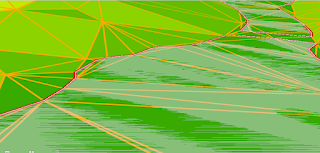Lab 4 [GIS5935]: Surfaces - TINs and DEMs

Raster-based digital elevation models (DEMs) and vector-based triangulated irregular networks (TINs) are two alternative methods to represent digital topography. A DEM is sampled at a particular resolution and can only be made more accurate if the raster is resampled to a higher resolution. Alternatively, to make a TIN more accurate, additional points and breaklines can be added. For example, in the image below, to make the sharp boundaries around a lake more accurate, the TIN has been forced to use the exact boundaries and elevation of the lake polygon (shown in red): In the enhanced TIN above, notice how the TIN grid aligns perfectly along the shoreline with the addition of many more triangular cells in this area. Additionally, more triangles appear near the bends in the shoreline to more accurately capture these details. In this lab, we also learned how contour lines differ when derived from DEMs versus TINs. We observed that contour lines generated from a DEM are much smoother in...



